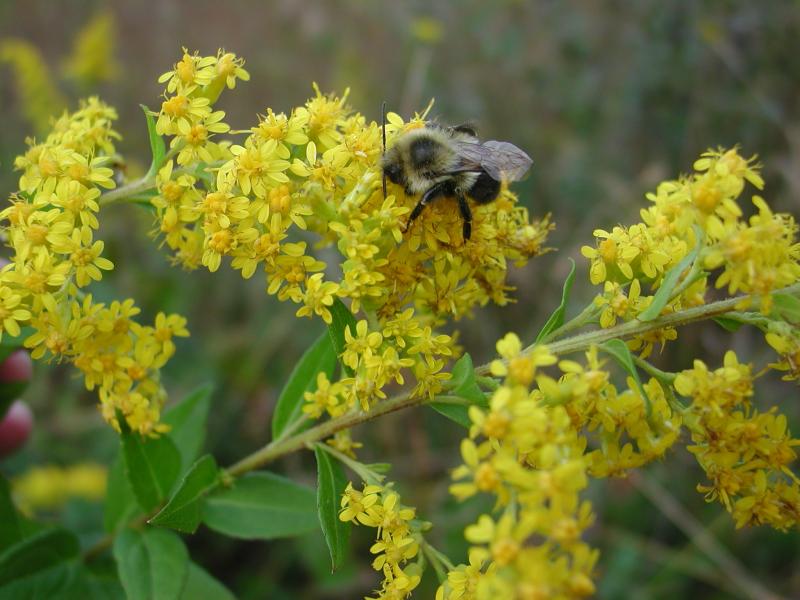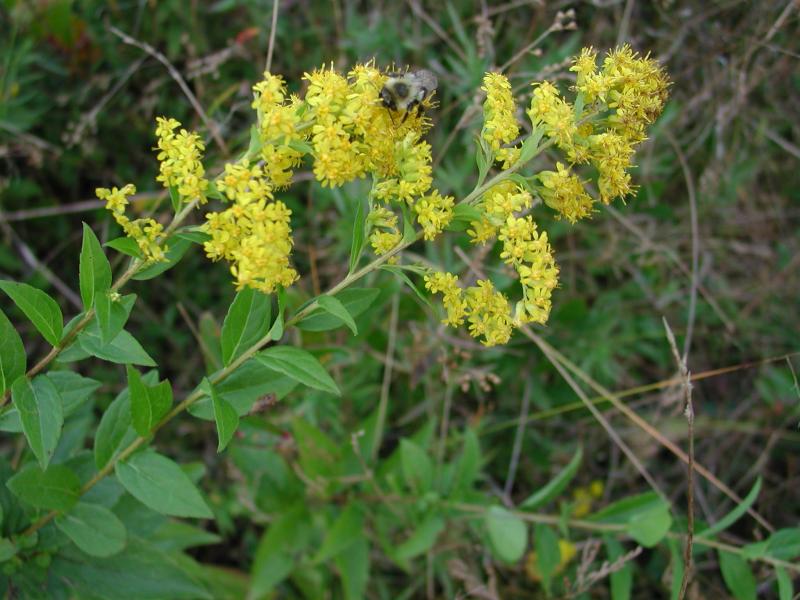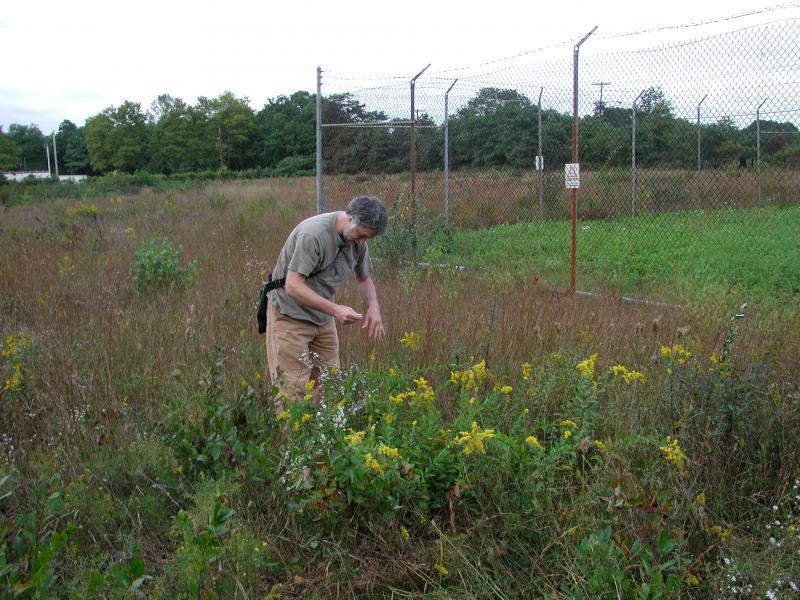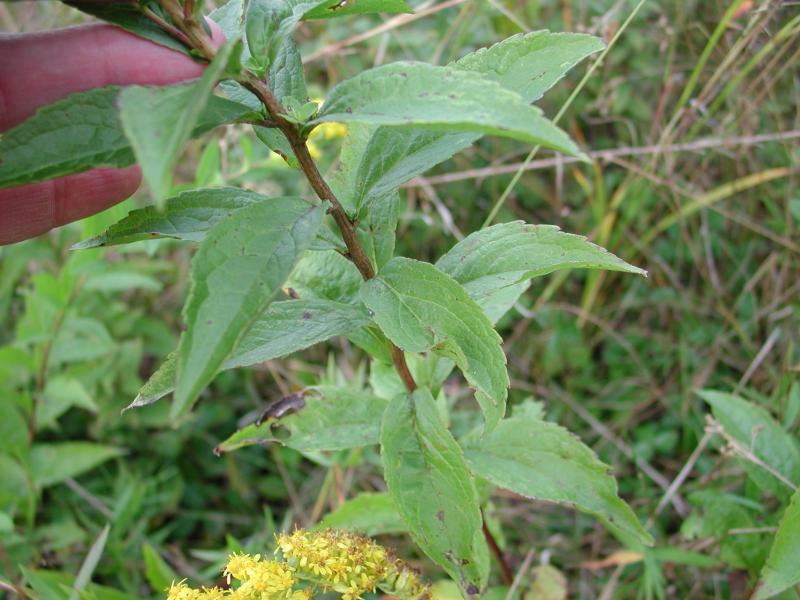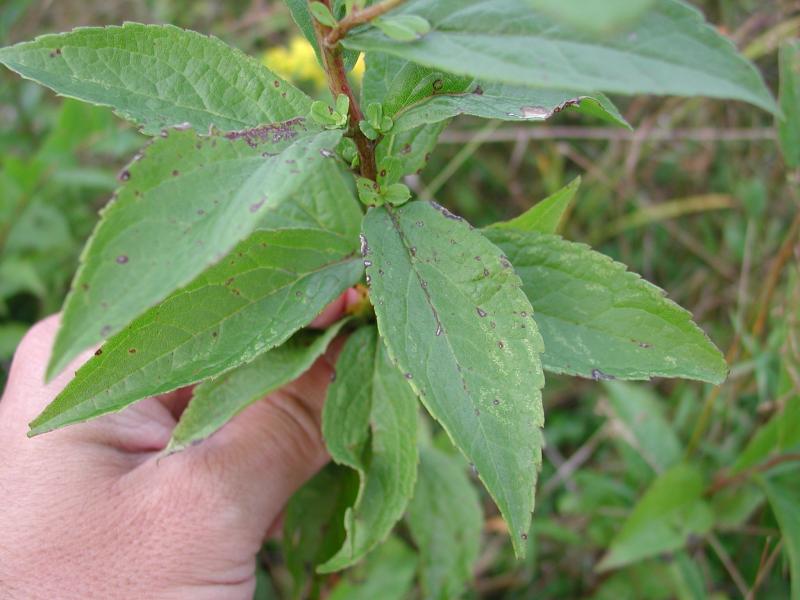Coastal Goldenrod
Solidago latissimifolia P. Mill.
- Class
- Dicotyledoneae (Dicots)
- Family
- Asteraceae (Aster Family)
- State Protection
- Endangered
Listed as Endangered by New York State: in imminent danger of extirpation in New York. For animals, taking, importation, transportation, or possession is prohibited, except under license or permit. For plants, removal or damage without the consent of the landowner is prohibited.
- Federal Protection
- Not Listed
- State Conservation Status Rank
- S1
Critically Imperiled in New York - Especially vulnerable to disappearing from New York due to extreme rarity or other factors; typically 5 or fewer populations or locations in New York, very few individuals, very restricted range, very few remaining acres (or miles of stream), and/or very steep declines.
- Global Conservation Status Rank
- G5
Secure globally - Common in the world; widespread and abundant (but may be rare in some parts of its range).
Summary
Did you know?
The species name means very wide leaves, even though the leaves of this goldenrod are no wider than most of the other species in the genus.
State Ranking Justification
There are four existing populations, but only one of them has more than 100 plants. There are 23 historical localities and most of them have been resurveyed. There may be more plants hidden among the other goldenrods.
Short-term Trends
The short-term trend is unknown due to a lack of recent surveys.
Long-term Trends
The long-term trend is strongly negative. There has been a substantial decline in the number and size of populations in the last 100 years as more open areas of Long Island were developed.
Conservation and Management
Threats
The lack of management to provide a proper disturbance for this species is its biggest threat.
Conservation Strategies and Management Practices
Disturbance regimes that optimize population numbers need to be maintained.
Research Needs
Studies should be done to see if present populations can be augmented. Research is also needed to provide the best interval and season of disturbance to optimize population numbers.
Habitat
Habitat
In New York, two populations occur in brackish to freshwater wet meadows. Another population occurs in a moist, sandy/gravelly, human-made opening in pitch pine oak woods in association with wildflowers and grasses (New York Natural Heritage Program 2012). Fresh and brackish swamps and thickets (FNA 2002).
Associated Ecological Communities
- Brackish meadow
(guide)
A moist, moderately well-drained brackish (salinity 0.5-18 ppt) perennial grassland with occasional isolated shrubs that is typically situated in a belt at the upper edge of salt marshes bordering sandy uplands, but may occupy large portions of interdunal basins. The community usually develops in areas with a unique combination of soils and hydrology, on deep deposits of periodically windblown or overwashed gleyed sands that are usually flooded only during spring tides and during major coastal storms, approximately two to three times per year.
- Pitch pine-oak forest
(guide)
A mixed forest that typically occurs on well-drained, sandy soils of glacial outwash plains or moraines; it also occurs on thin, rocky soils of ridgetops. The dominant trees are pitch pine mixed with one or more of the following oaks: scarlet oak, white oak, red oak, or black oak.
Associated Species
- Carex folliculata (long sedge)
- Carex lupulina (hop sedge)
- Eupatorium rotundifolium (round-leaved thoroughwort)
- Juncus biflorus (large grass-leaved rush)
- Panicum virgatum (switch grass)
- Photinia melanocarpa
- Rhus copallinum
- Rhynchospora
- Scleria triglomerata (whip nut sedge)
- Solidago rugosa
Range
New York State Distribution
This goldenrod is currently known from Suffolk County, Long Island and was once known to the west in Nassau and Queens counties where it is probably extirpated.
Global Distribution
This goldenrod occurs from Nova Scotia and eastern Massachusetts south along the Atlantic Coastal Plain to northern Florida and west along the Gulf Coast in the panhandle of Florida, southern Alabama and Mississippi.
Identification Comments
General Description
Coastal goldenrod is an erect wildflower that grows 1-3 meters tall from a long creeping rhizome. There may be 1-5 stems per plant. They are hairless or may contain hairs within the branches of the inflorescence. The basal and lower stem leaves wither by flowering time. The leaves on the middle and upper part of the stem are sessile, elliptic or lanceolate-elliptic, toothed, 60-150 mm long and only a little reduced in size toward the top of the stem. They are hairless, not 3-nerved, slightly roughened, and have a conspicuous net of veins visible. There are 35-800 flower heads of in open panicles which sometimes have bracts within them. The branches are slightly to strongly curved down with flowers growing on one side of the branch. The involucres are bell-shaped and 4-6 mm long. The involucral bracts are in a 4-5 series, hairless and 0.7-1.2 mm wide. The yellow ray flowers are 2-3 mm long (FNA 2002).
Identifying Characteristics
Distinguishing characteristics: stems from a creeping stoloniferous base, glabrous throughout; leaves numerous, oblanceolate to elliptic, membranaceous, glabrous throughout; panicle with smooth or but slightly pilose branches; involucres (3.5) 4-6 (6.5) mm high; bracts broad, the larger ones 0.7-1.2 mm wide; disk flowers 2-7, their corollas 4-5.5 mm long, with lobes 1.5-2 mm long; anthers 1.5-2 mm long; pappus 3- 5 mm long; achenes hispidulous, 1.5-1.8 mm long; restricted to the coast. Best life stage for ID: in flower. Characteristics needed to ID: stem with leaves and flowers.
Best Life Stage for Proper Identification
The best time to identify this goldenrod is when it is in flower.
Similar Species
There are three closely related goldenrods that occur within the range of coastal goldenrod. Solidago odora and Solidago ulmifolia grow from short, not elongate rhizomes. Solidago odora has narrowly lance-shaped leaves that sometimes smell like anise when crushed. Solidago ulmifolia has leaves that are slightly hairy with short to long petioles. Solidago rugosa also grows from creeping rhizomes but is much more common. The stems are hairy the entire length and the leaves of the mid-stem are more lanceolate to ovate instead of elliptic (FNA 2002).
Best Time to See
Flowres September through October.
- Flowering
- Fruiting
The time of year you would expect to find Coastal Goldenrod flowering and fruiting in New York.
Coastal Goldenrod Images
Taxonomy
Coastal Goldenrod
Solidago latissimifolia P. Mill.
- Kingdom Plantae
- Phylum Anthophyta
- Class Dicotyledoneae
(Dicots)
- Order Asterales
- Family Asteraceae (Aster Family)
- Order Asterales
- Class Dicotyledoneae
(Dicots)
- Phylum Anthophyta
Synonyms
- Solidago elliottii Torr. & Gray
Additional Resources
Best Identification Reference
Flora of North America Editorial Committee. 2006. Flora of North America North of Mexico. Vol. 20. Magnoliophyta: Asteridae, Part 7: Asteraceae, part 2. Oxford Univ. Press, New York. xxii + 666 pp.
Other References
Clemants, Steven and Carol Gracie. 2006. Wildflowers in the Field and Forest. A Field Guide to the Northeastern United States. Oxford University Press, New York, NY. 445 pp.
Fernald, M.L. 1950. Gray's manual of botany. 8th edition. D. Van Nostrand, New York. 1632 pp.
Gleason, Henry A. and A. Cronquist. 1991. Manual of Vascular Plants of Northeastern United States and Adjacent Canada. The New York Botanical Garden, Bronx, New York. 910 pp.
Holmgren, Noel. 1998. The Illustrated Companion to Gleason and Cronquist's Manual. Illustrations of the Vascular Plants of Northeastern United States and Adjacent Canada. The New York Botanical Garden, Bronx, New York.
Mitchell, Richard S. and Gordon C. Tucker. 1997. Revised Checklist of New York State Plants. Contributions to a Flora of New York State. Checklist IV. Bulletin No. 490. New York State Museum. Albany, NY. 400 pp.
New York Natural Heritage Program. 2010. Biotics database. New York Natural Heritage Program. New York State Department of Environmental Conservation. Albany, NY.
New York Natural Heritage Program. 2024. New York Natural Heritage Program Databases. Albany, NY.
Newcomb, Lawrence. 1977. Newcomb's Wildflower Guide: An Ingenious New Key System for Quick, Positive Field Identification of the Wildflowers, Flowering Shrubs, and Vines of Northeastern and North-Central North America. Little, Brown and Company. Boston.
Weldy, T. and D. Werier. 2010. New York flora atlas. [S.M. Landry, K.N. Campbell, and L.D. Mabe (original application development), Florida Center for Community Design and Research http://www.fccdr.usf.edu/. University of South Florida http://www.usf.edu/]. New York Flora Association http://newyork.plantatlas.usf.edu/, Albany, New York
Links
About This Guide
This guide was authored by: Stephen M. Young
Information for this guide was last updated on: September 6, 2012
Please cite this page as:
New York Natural Heritage Program. 2024.
Online Conservation Guide for
Solidago latissimifolia.
Available from: https://guides.nynhp.org/coastal-goldenrod/.
Accessed July 27, 2024.
